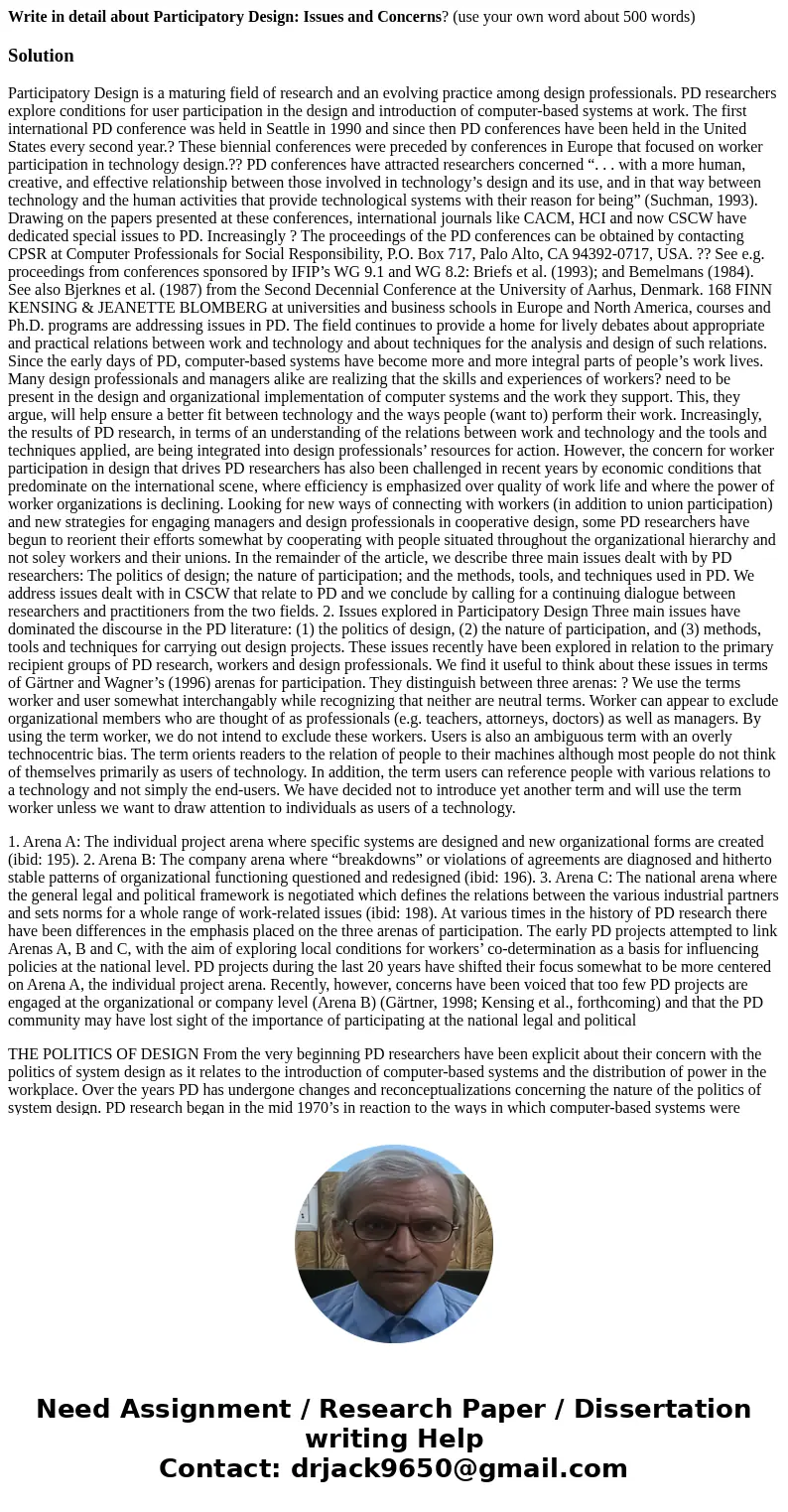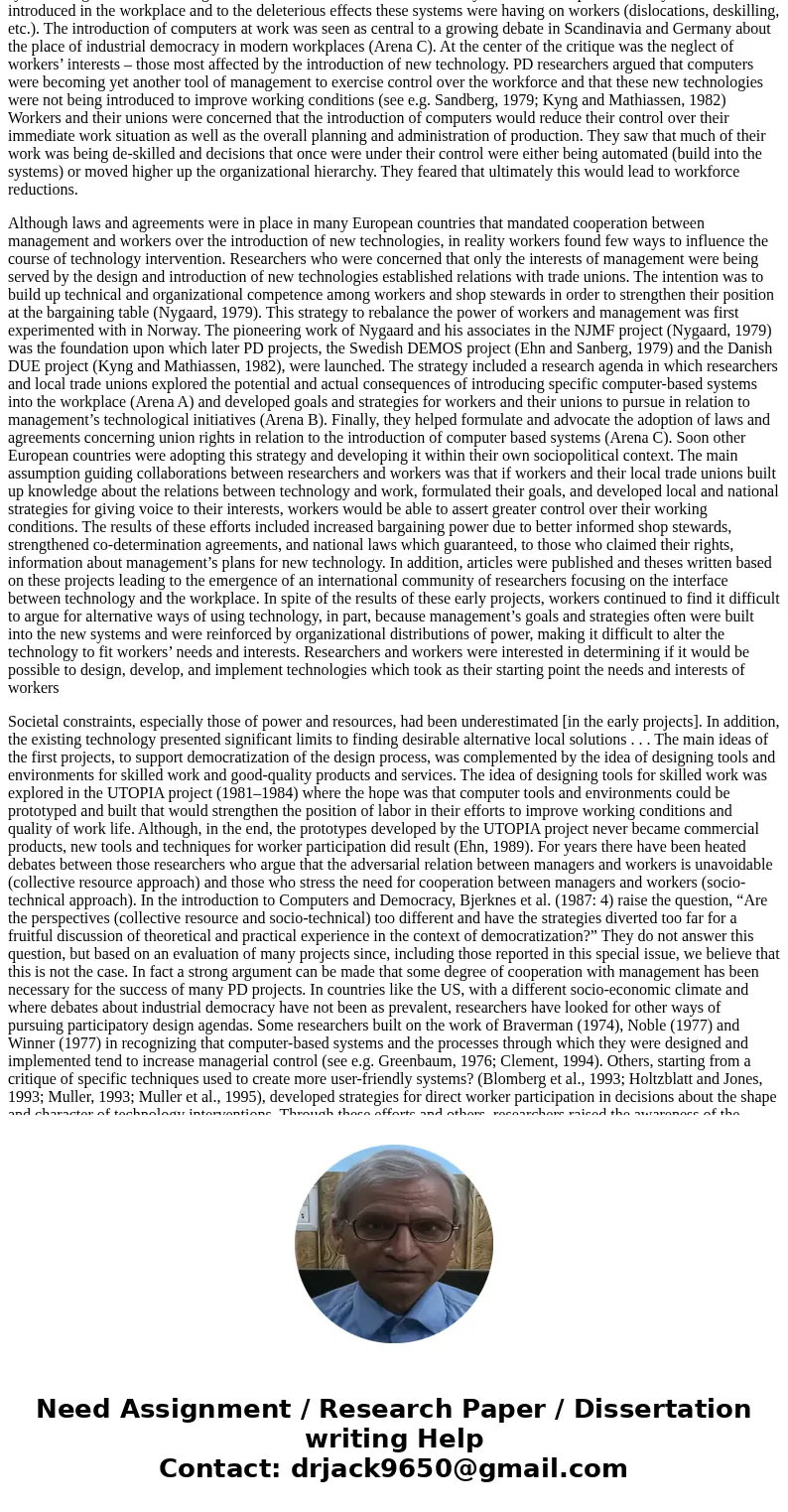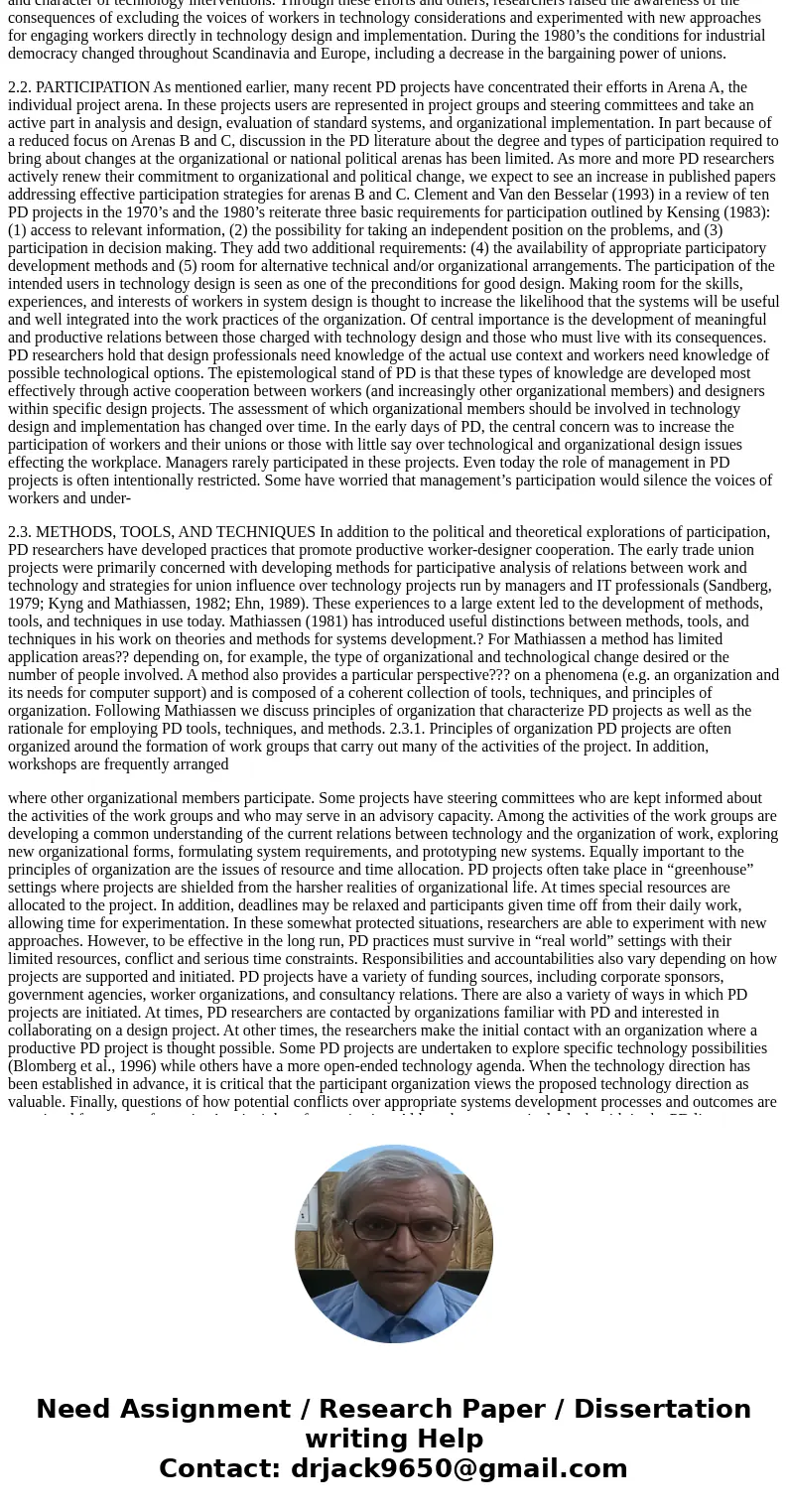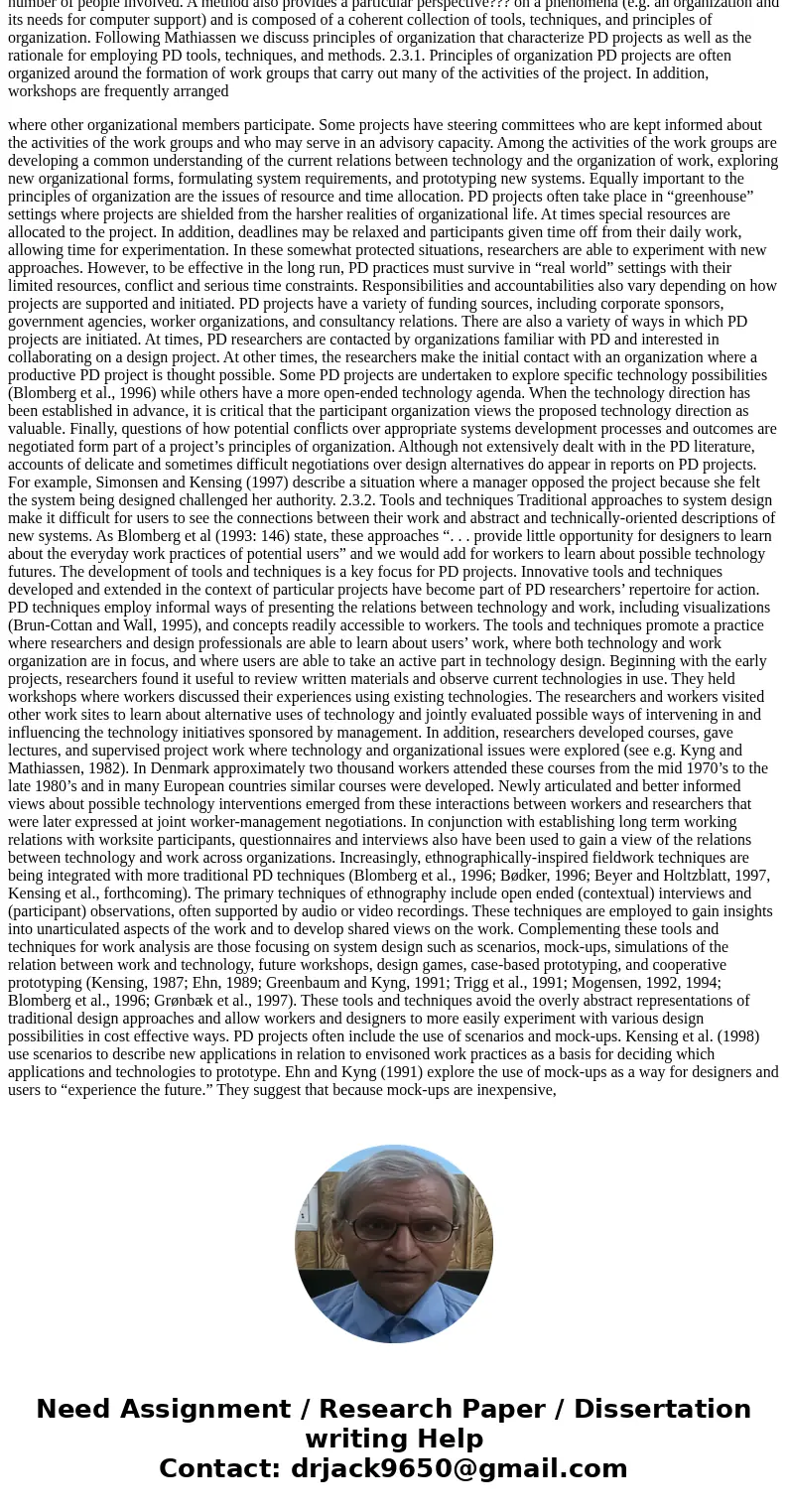Write in detail about Participatory Design Issues and Concer
Write in detail about Participatory Design: Issues and Concerns? (use your own word about 500 words)
Solution
Participatory Design is a maturing field of research and an evolving practice among design professionals. PD researchers explore conditions for user participation in the design and introduction of computer-based systems at work. The first international PD conference was held in Seattle in 1990 and since then PD conferences have been held in the United States every second year.? These biennial conferences were preceded by conferences in Europe that focused on worker participation in technology design.?? PD conferences have attracted researchers concerned “. . . with a more human, creative, and effective relationship between those involved in technology’s design and its use, and in that way between technology and the human activities that provide technological systems with their reason for being” (Suchman, 1993). Drawing on the papers presented at these conferences, international journals like CACM, HCI and now CSCW have dedicated special issues to PD. Increasingly ? The proceedings of the PD conferences can be obtained by contacting CPSR at Computer Professionals for Social Responsibility, P.O. Box 717, Palo Alto, CA 94392-0717, USA. ?? See e.g. proceedings from conferences sponsored by IFIP’s WG 9.1 and WG 8.2: Briefs et al. (1993); and Bemelmans (1984). See also Bjerknes et al. (1987) from the Second Decennial Conference at the University of Aarhus, Denmark. 168 FINN KENSING & JEANETTE BLOMBERG at universities and business schools in Europe and North America, courses and Ph.D. programs are addressing issues in PD. The field continues to provide a home for lively debates about appropriate and practical relations between work and technology and about techniques for the analysis and design of such relations. Since the early days of PD, computer-based systems have become more and more integral parts of people’s work lives. Many design professionals and managers alike are realizing that the skills and experiences of workers? need to be present in the design and organizational implementation of computer systems and the work they support. This, they argue, will help ensure a better fit between technology and the ways people (want to) perform their work. Increasingly, the results of PD research, in terms of an understanding of the relations between work and technology and the tools and techniques applied, are being integrated into design professionals’ resources for action. However, the concern for worker participation in design that drives PD researchers has also been challenged in recent years by economic conditions that predominate on the international scene, where efficiency is emphasized over quality of work life and where the power of worker organizations is declining. Looking for new ways of connecting with workers (in addition to union participation) and new strategies for engaging managers and design professionals in cooperative design, some PD researchers have begun to reorient their efforts somewhat by cooperating with people situated throughout the organizational hierarchy and not soley workers and their unions. In the remainder of the article, we describe three main issues dealt with by PD researchers: The politics of design; the nature of participation; and the methods, tools, and techniques used in PD. We address issues dealt with in CSCW that relate to PD and we conclude by calling for a continuing dialogue between researchers and practitioners from the two fields. 2. Issues explored in Participatory Design Three main issues have dominated the discourse in the PD literature: (1) the politics of design, (2) the nature of participation, and (3) methods, tools and techniques for carrying out design projects. These issues recently have been explored in relation to the primary recipient groups of PD research, workers and design professionals. We find it useful to think about these issues in terms of Gärtner and Wagner’s (1996) arenas for participation. They distinguish between three arenas: ? We use the terms worker and user somewhat interchangably while recognizing that neither are neutral terms. Worker can appear to exclude organizational members who are thought of as professionals (e.g. teachers, attorneys, doctors) as well as managers. By using the term worker, we do not intend to exclude these workers. Users is also an ambiguous term with an overly technocentric bias. The term orients readers to the relation of people to their machines although most people do not think of themselves primarily as users of technology. In addition, the term users can reference people with various relations to a technology and not simply the end-users. We have decided not to introduce yet another term and will use the term worker unless we want to draw attention to individuals as users of a technology.
1. Arena A: The individual project arena where specific systems are designed and new organizational forms are created (ibid: 195). 2. Arena B: The company arena where “breakdowns” or violations of agreements are diagnosed and hitherto stable patterns of organizational functioning questioned and redesigned (ibid: 196). 3. Arena C: The national arena where the general legal and political framework is negotiated which defines the relations between the various industrial partners and sets norms for a whole range of work-related issues (ibid: 198). At various times in the history of PD research there have been differences in the emphasis placed on the three arenas of participation. The early PD projects attempted to link Arenas A, B and C, with the aim of exploring local conditions for workers’ co-determination as a basis for influencing policies at the national level. PD projects during the last 20 years have shifted their focus somewhat to be more centered on Arena A, the individual project arena. Recently, however, concerns have been voiced that too few PD projects are engaged at the organizational or company level (Arena B) (Gärtner, 1998; Kensing et al., forthcoming) and that the PD community may have lost sight of the importance of participating at the national legal and political
THE POLITICS OF DESIGN From the very beginning PD researchers have been explicit about their concern with the politics of system design as it relates to the introduction of computer-based systems and the distribution of power in the workplace. Over the years PD has undergone changes and reconceptualizations concerning the nature of the politics of system design. PD research began in the mid 1970’s in reaction to the ways in which computer-based systems were introduced in the workplace and to the deleterious effects these systems were having on workers (dislocations, deskilling, etc.). The introduction of computers at work was seen as central to a growing debate in Scandinavia and Germany about the place of industrial democracy in modern workplaces (Arena C). At the center of the critique was the neglect of workers’ interests – those most affected by the introduction of new technology. PD researchers argued that computers were becoming yet another tool of management to exercise control over the workforce and that these new technologies were not being introduced to improve working conditions (see e.g. Sandberg, 1979; Kyng and Mathiassen, 1982) Workers and their unions were concerned that the introduction of computers would reduce their control over their immediate work situation as well as the overall planning and administration of production. They saw that much of their work was being de-skilled and decisions that once were under their control were either being automated (build into the systems) or moved higher up the organizational hierarchy. They feared that ultimately this would lead to workforce reductions.
Although laws and agreements were in place in many European countries that mandated cooperation between management and workers over the introduction of new technologies, in reality workers found few ways to influence the course of technology intervention. Researchers who were concerned that only the interests of management were being served by the design and introduction of new technologies established relations with trade unions. The intention was to build up technical and organizational competence among workers and shop stewards in order to strengthen their position at the bargaining table (Nygaard, 1979). This strategy to rebalance the power of workers and management was first experimented with in Norway. The pioneering work of Nygaard and his associates in the NJMF project (Nygaard, 1979) was the foundation upon which later PD projects, the Swedish DEMOS project (Ehn and Sanberg, 1979) and the Danish DUE project (Kyng and Mathiassen, 1982), were launched. The strategy included a research agenda in which researchers and local trade unions explored the potential and actual consequences of introducing specific computer-based systems into the workplace (Arena A) and developed goals and strategies for workers and their unions to pursue in relation to management’s technological initiatives (Arena B). Finally, they helped formulate and advocate the adoption of laws and agreements concerning union rights in relation to the introduction of computer based systems (Arena C). Soon other European countries were adopting this strategy and developing it within their own sociopolitical context. The main assumption guiding collaborations between researchers and workers was that if workers and their local trade unions built up knowledge about the relations between technology and work, formulated their goals, and developed local and national strategies for giving voice to their interests, workers would be able to assert greater control over their working conditions. The results of these efforts included increased bargaining power due to better informed shop stewards, strengthened co-determination agreements, and national laws which guaranteed, to those who claimed their rights, information about management’s plans for new technology. In addition, articles were published and theses written based on these projects leading to the emergence of an international community of researchers focusing on the interface between technology and the workplace. In spite of the results of these early projects, workers continued to find it difficult to argue for alternative ways of using technology, in part, because management’s goals and strategies often were built into the new systems and were reinforced by organizational distributions of power, making it difficult to alter the technology to fit workers’ needs and interests. Researchers and workers were interested in determining if it would be possible to design, develop, and implement technologies which took as their starting point the needs and interests of workers
Societal constraints, especially those of power and resources, had been underestimated [in the early projects]. In addition, the existing technology presented significant limits to finding desirable alternative local solutions . . . The main ideas of the first projects, to support democratization of the design process, was complemented by the idea of designing tools and environments for skilled work and good-quality products and services. The idea of designing tools for skilled work was explored in the UTOPIA project (1981–1984) where the hope was that computer tools and environments could be prototyped and built that would strengthen the position of labor in their efforts to improve working conditions and quality of work life. Although, in the end, the prototypes developed by the UTOPIA project never became commercial products, new tools and techniques for worker participation did result (Ehn, 1989). For years there have been heated debates between those researchers who argue that the adversarial relation between managers and workers is unavoidable (collective resource approach) and those who stress the need for cooperation between managers and workers (socio-technical approach). In the introduction to Computers and Democracy, Bjerknes et al. (1987: 4) raise the question, “Are the perspectives (collective resource and socio-technical) too different and have the strategies diverted too far for a fruitful discussion of theoretical and practical experience in the context of democratization?” They do not answer this question, but based on an evaluation of many projects since, including those reported in this special issue, we believe that this is not the case. In fact a strong argument can be made that some degree of cooperation with management has been necessary for the success of many PD projects. In countries like the US, with a different socio-economic climate and where debates about industrial democracy have not been as prevalent, researchers have looked for other ways of pursuing participatory design agendas. Some researchers built on the work of Braverman (1974), Noble (1977) and Winner (1977) in recognizing that computer-based systems and the processes through which they were designed and implemented tend to increase managerial control (see e.g. Greenbaum, 1976; Clement, 1994). Others, starting from a critique of specific techniques used to create more user-friendly systems? (Blomberg et al., 1993; Holtzblatt and Jones, 1993; Muller, 1993; Muller et al., 1995), developed strategies for direct worker participation in decisions about the shape and character of technology interventions. Through these efforts and others, researchers raised the awareness of the consequences of excluding the voices of workers in technology considerations and experimented with new approaches for engaging workers directly in technology design and implementation. During the 1980’s the conditions for industrial democracy changed throughout Scandinavia and Europe, including a decrease in the bargaining power of unions.
2.2. PARTICIPATION As mentioned earlier, many recent PD projects have concentrated their efforts in Arena A, the individual project arena. In these projects users are represented in project groups and steering committees and take an active part in analysis and design, evaluation of standard systems, and organizational implementation. In part because of a reduced focus on Arenas B and C, discussion in the PD literature about the degree and types of participation required to bring about changes at the organizational or national political arenas has been limited. As more and more PD researchers actively renew their commitment to organizational and political change, we expect to see an increase in published papers addressing effective participation strategies for arenas B and C. Clement and Van den Besselar (1993) in a review of ten PD projects in the 1970’s and the 1980’s reiterate three basic requirements for participation outlined by Kensing (1983): (1) access to relevant information, (2) the possibility for taking an independent position on the problems, and (3) participation in decision making. They add two additional requirements: (4) the availability of appropriate participatory development methods and (5) room for alternative technical and/or organizational arrangements. The participation of the intended users in technology design is seen as one of the preconditions for good design. Making room for the skills, experiences, and interests of workers in system design is thought to increase the likelihood that the systems will be useful and well integrated into the work practices of the organization. Of central importance is the development of meaningful and productive relations between those charged with technology design and those who must live with its consequences. PD researchers hold that design professionals need knowledge of the actual use context and workers need knowledge of possible technological options. The epistemological stand of PD is that these types of knowledge are developed most effectively through active cooperation between workers (and increasingly other organizational members) and designers within specific design projects. The assessment of which organizational members should be involved in technology design and implementation has changed over time. In the early days of PD, the central concern was to increase the participation of workers and their unions or those with little say over technological and organizational design issues effecting the workplace. Managers rarely participated in these projects. Even today the role of management in PD projects is often intentionally restricted. Some have worried that management’s participation would silence the voices of workers and under-
2.3. METHODS, TOOLS, AND TECHNIQUES In addition to the political and theoretical explorations of participation, PD researchers have developed practices that promote productive worker-designer cooperation. The early trade union projects were primarily concerned with developing methods for participative analysis of relations between work and technology and strategies for union influence over technology projects run by managers and IT professionals (Sandberg, 1979; Kyng and Mathiassen, 1982; Ehn, 1989). These experiences to a large extent led to the development of methods, tools, and techniques in use today. Mathiassen (1981) has introduced useful distinctions between methods, tools, and techniques in his work on theories and methods for systems development.? For Mathiassen a method has limited application areas?? depending on, for example, the type of organizational and technological change desired or the number of people involved. A method also provides a particular perspective??? on a phenomena (e.g. an organization and its needs for computer support) and is composed of a coherent collection of tools, techniques, and principles of organization. Following Mathiassen we discuss principles of organization that characterize PD projects as well as the rationale for employing PD tools, techniques, and methods. 2.3.1. Principles of organization PD projects are often organized around the formation of work groups that carry out many of the activities of the project. In addition, workshops are frequently arranged
where other organizational members participate. Some projects have steering committees who are kept informed about the activities of the work groups and who may serve in an advisory capacity. Among the activities of the work groups are developing a common understanding of the current relations between technology and the organization of work, exploring new organizational forms, formulating system requirements, and prototyping new systems. Equally important to the principles of organization are the issues of resource and time allocation. PD projects often take place in “greenhouse” settings where projects are shielded from the harsher realities of organizational life. At times special resources are allocated to the project. In addition, deadlines may be relaxed and participants given time off from their daily work, allowing time for experimentation. In these somewhat protected situations, researchers are able to experiment with new approaches. However, to be effective in the long run, PD practices must survive in “real world” settings with their limited resources, conflict and serious time constraints. Responsibilities and accountabilities also vary depending on how projects are supported and initiated. PD projects have a variety of funding sources, including corporate sponsors, government agencies, worker organizations, and consultancy relations. There are also a variety of ways in which PD projects are initiated. At times, PD researchers are contacted by organizations familiar with PD and interested in collaborating on a design project. At other times, the researchers make the initial contact with an organization where a productive PD project is thought possible. Some PD projects are undertaken to explore specific technology possibilities (Blomberg et al., 1996) while others have a more open-ended technology agenda. When the technology direction has been established in advance, it is critical that the participant organization views the proposed technology direction as valuable. Finally, questions of how potential conflicts over appropriate systems development processes and outcomes are negotiated form part of a project’s principles of organization. Although not extensively dealt with in the PD literature, accounts of delicate and sometimes difficult negotiations over design alternatives do appear in reports on PD projects. For example, Simonsen and Kensing (1997) describe a situation where a manager opposed the project because she felt the system being designed challenged her authority. 2.3.2. Tools and techniques Traditional approaches to system design make it difficult for users to see the connections between their work and abstract and technically-oriented descriptions of new systems. As Blomberg et al (1993: 146) state, these approaches “. . . provide little opportunity for designers to learn about the everyday work practices of potential users” and we would add for workers to learn about possible technology futures. The development of tools and techniques is a key focus for PD projects. Innovative tools and techniques developed and extended in the context of particular projects have become part of PD researchers’ repertoire for action. PD techniques employ informal ways of presenting the relations between technology and work, including visualizations (Brun-Cottan and Wall, 1995), and concepts readily accessible to workers. The tools and techniques promote a practice where researchers and design professionals are able to learn about users’ work, where both technology and work organization are in focus, and where users are able to take an active part in technology design. Beginning with the early projects, researchers found it useful to review written materials and observe current technologies in use. They held workshops where workers discussed their experiences using existing technologies. The researchers and workers visited other work sites to learn about alternative uses of technology and jointly evaluated possible ways of intervening in and influencing the technology initiatives sponsored by management. In addition, researchers developed courses, gave lectures, and supervised project work where technology and organizational issues were explored (see e.g. Kyng and Mathiassen, 1982). In Denmark approximately two thousand workers attended these courses from the mid 1970’s to the late 1980’s and in many European countries similar courses were developed. Newly articulated and better informed views about possible technology interventions emerged from these interactions between workers and researchers that were later expressed at joint worker-management negotiations. In conjunction with establishing long term working relations with worksite participants, questionnaires and interviews also have been used to gain a view of the relations between technology and work across organizations. Increasingly, ethnographically-inspired fieldwork techniques are being integrated with more traditional PD techniques (Blomberg et al., 1996; Bødker, 1996; Beyer and Holtzblatt, 1997, Kensing et al., forthcoming). The primary techniques of ethnography include open ended (contextual) interviews and (participant) observations, often supported by audio or video recordings. These techniques are employed to gain insights into unarticulated aspects of the work and to develop shared views on the work. Complementing these tools and techniques for work analysis are those focusing on system design such as scenarios, mock-ups, simulations of the relation between work and technology, future workshops, design games, case-based prototyping, and cooperative prototyping (Kensing, 1987; Ehn, 1989; Greenbaum and Kyng, 1991; Trigg et al., 1991; Mogensen, 1992, 1994; Blomberg et al., 1996; Grønbæk et al., 1997). These tools and techniques avoid the overly abstract representations of traditional design approaches and allow workers and designers to more easily experiment with various design possibilities in cost effective ways. PD projects often include the use of scenarios and mock-ups. Kensing et al. (1998) use scenarios to describe new applications in relation to envisoned work practices as a basis for deciding which applications and technologies to prototype. Ehn and Kyng (1991) explore the use of mock-ups as a way for designers and users to “experience the future.” They suggest that because mock-ups are inexpensive,




 Homework Sourse
Homework Sourse